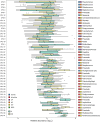Pyrosequencing Unveils Cystic Fibrosis Lung Microbiome Differences Associated with a Severe Lung Function Decline
- PMID: 27355625
- PMCID: PMC4927098
- DOI: 10.1371/journal.pone.0156807
Pyrosequencing Unveils Cystic Fibrosis Lung Microbiome Differences Associated with a Severe Lung Function Decline
Erratum in
-
Correction: Pyrosequencing Unveils Cystic Fibrosis Lung Microbiome Differences Associated with a Severe Lung Function Decline.PLoS One. 2016 Aug 1;11(8):e0160726. doi: 10.1371/journal.pone.0160726. eCollection 2016. PLoS One. 2016. PMID: 27478895 Free PMC article.
Abstract
Chronic airway infection is a hallmark feature of cystic fibrosis (CF) disease. In the present study, sputum samples from CF patients were collected and characterized by 16S rRNA gene-targeted approach, to assess how lung microbiota composition changes following a severe decline in lung function. In particular, we compared the airway microbiota of two groups of patients with CF, i.e. patients with a substantial decline in their lung function (SD) and patients with a stable lung function (S). The two groups showed a different bacterial composition, with SD patients reporting a more heterogeneous community than the S ones. Pseudomonas was the dominant genus in both S and SD patients followed by Staphylococcus and Prevotella. Other than the classical CF pathogens and the most commonly identified non-classical genera in CF, we found the presence of the unusual anaerobic genus Sneathia. Moreover, the oligotyping analysis revealed the presence of other minor genera described in CF, highlighting the polymicrobial nature of CF infection. Finally, the analysis of correlation and anti-correlation networks showed the presence of antagonism and ecological independence between members of Pseudomonas genus and the rest of CF airways microbiota, with S patients showing a more interconnected community in S patients than in SD ones. This population structure suggests a higher resilience of S microbiota with respect to SD, which in turn may hinder the potential adverse impact of aggressive pathogens (e.g. Pseudomonas). In conclusion, our findings shed a new light on CF airway microbiota ecology, improving current knowledge about its composition and polymicrobial interactions in patients with CF.
Conflict of interest statement
Figures




References
-
- Sibley CD, Parkins MD, Rabin HR, Surette MG. The relevance of the polymicrobial nature of airway infection in the acute and chronic management of patients with cystic fibrosis. Curr Opin Investig Drugs. 2009;10: 787–794. - PubMed
Publication types
MeSH terms
Substances
LinkOut - more resources
Full Text Sources
Other Literature Sources
Medical

